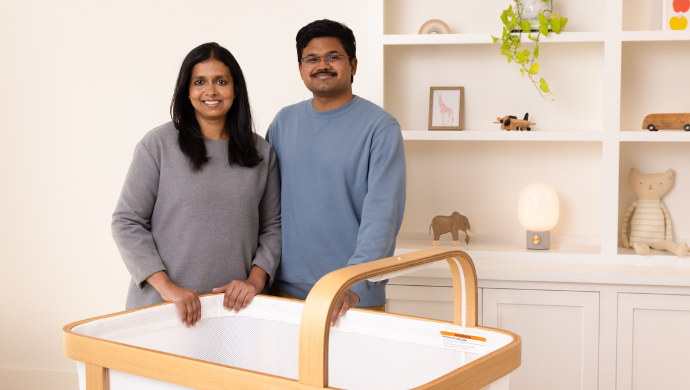Cradlewise: The smart crib that caught Sam Altman’s eye

[L-R] Cradlewise co-founders Radhika (CEO) and Bharath Patil (CTO)
The genesis of Cradlewise wasn’t in a sterile boardroom but in the chaotic reality of new parenthood. For Radhika and Bharath Patil, co-founders of Cradlewise, the early days with their first child were a blur of 30-minute sleep cycles and desperate attempts to soothe their baby back to sleep.
Amidst the exhaustion, an idea began to take shape: What if a crib could sense when a baby was about to wake and gently lull them back to sleep before they even cried?
That moment of desperation became the foundation for Cradlewise, a smart crib powered by AI that proactively soothes babies back to sleep using gentle bouncing and sound.
Also Read: The future isn’t people or machine — It’s people with machine
As engineers, the Patils had the technical expertise to tackle the challenge personally. However, being parents shapes the heart of the product. Their two children became the first “test engineers”, influencing early prototypes and features that no formal study could replicate.
Every design decision reflected their personal experience: from avoiding traditional cage-like cribs to designing something warm, calm, and beautiful — an emotional centrepiece of the nursery.
“We didn’t want Cradlewise to feel cage-like, with the traditional vertical slats. We wanted it to be warm, calming, and beautiful because a crib is not just a piece of furniture, it’s an emotional purchase. It becomes part of the nursery, the nighttime routine, and the memories,” Radhika shares.
Made of natural materials
One breakthrough was developing a bouncing mechanism that replicated the rhythmic motion of a parent’s arms — whisper-quiet yet comforting. The materials, too, were chosen with care: Cradlewise uses only GREENGUARD Gold certified, baby-safe components, opting for organic coconut coir and natural latex over standard PU foam mattresses. As Radhika puts it, “If I wouldn’t use it for my baby, it has no place in Cradlewise.”
Understanding that it “takes a village to raise a child,” Cradlewise also introduced a feature allowing grandparents and extended family to access the crib remotely, fostering emotional bonds across distances.
When it came to safety, Cradlewise pursued every major certification in the US and Canada. “At the end of the day, no feature matters more than knowing your baby is safe — and deeply loved,” says Radhika.
Akin to building an airplane mid-flight
The path to building Cradlewise wasn’t easy, especially with the COVID-19 pandemic disrupting supply chains, skyrocketing shipping costs, and forcing the team into remote work. “It felt like building an airplane mid-flight — with turbulence, no spare parts, and a baby on board,” Radhika recalls.
Yet, amid the challenges, the pandemic offered a hidden advantage: time. Slower timelines allowed the team to dig deep into product development, analyse user feedback, and fine-tune the crib. At a time when parents were isolated from traditional support systems, the value of Cradlewise’s promise — better sleep and peace of mind — resonated even more powerfully.
AI-powered contactless monitor
At the heart of Cradlewise is intelligent technology. The crib uses a contactless monitor to detect subtle early signs of a baby stirring and proactively soothes them with gentle motions and sounds. Over time, its AI learns both from a global database of user behaviour and the specific sleep patterns of each child, personalising the experience and improving sleep outcomes.
Building trust was central to Cradlewise’s success. Beyond rigorous safety standards, they engaged transparently with the parenting community, and positive testimonials from parents helped build their credibility organically.

Priced at INR 1,59,990 (under US$2,000), Cradlewise has gained strong traction in the US and Canadian markets, with babies logging over 30 million hours of sleep in Cradlewise cribs. The brand continues to see steady growth and is now expanding into India, Radhika claims.
Made in India for the world
As part of its long-term strategy, Cradlewise is transitioning its manufacturing base from China to Pune. According to Radhika, this move allows for greater quality control and faster lead times and aligns with India’s rising prominence in global manufacturing.
Within a year, they localised nearly 60 per cent of their supply chain, a shift that would have been unthinkable a few years ago. Only chipsets and semiconductors still need to be imported.
Entering India, however, requires a tailored approach. Recognising the market’s price sensitivity and different parenting styles, Cradlewise is positioning itself as a crib and an essential parenting ally, emphasising long-term value, extended usability, and robust safety.
Catching Sam Altman’s eye
A major validation came from Silicon Valley tech leader Sam Altman, who organically endorsed Cradlewise after using it for his child. Altman’s rare public praise significantly boosted the brand’s credibility, opening new doors and opportunities.
For Radhika, building Cradlewise has been a deeply personal journey, evolving from a frustrated new mother to an engineer-turned-entrepreneur. Motherhood honed her resilience; entrepreneurship tested it. Over the years, she transitioned from building hardware to leading global teams — sometimes while literally bouncing her babies during investor calls.
Also Read: AI revolution: Balancing human empathy and robotic efficiency in customer service
Looking ahead, Cradlewise has ambitious plans. Beyond the crib, they aim to create a connected kids’ room ecosystem — including a toddler bed — and become the “Apple of baby-tech,” seamlessly integrating hardware, software, and services for families.
Yet, at its core, Cradlewise’s mission remains profound and straightforward: to make parenting less stressful and more joyful— allowing parents to enjoy more quality time awake with their children.
The post Cradlewise: The smart crib that caught Sam Altman’s eye appeared first on e27.